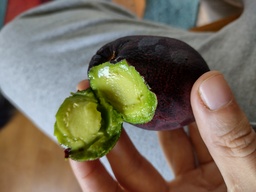Varieties

There are three races of avocado trees:
- Mexican (Persea americana var. drymifolia),
- Guatemalan (Persea americana var. guatemalensis), and
- West Indian (Persea americana var. americana).
Mexican avocados are typically small with thin, smooth, black skin which is also edible and has a taste of anise; the flesh is high in oil content. Guatemalan avocados are larger and have thick, pebbly skin. West Indian avocados (also sometimes called “Florida avocados” or “tropical avocados”) are the largest and have smooth, often green skin.
There is a lot of genetic variation in avocado trees, affecting everything from the colour, size, and shape of the fruit to the shape of the trees and things like cold hardiness, heat tolerance, and drought hardiness.
Of the three races, Mexican avocados are the most cold hardy.
A tree grown from seed and not grafted is known as a seedling. Each seedling is genetically unique and can have one or two parents (the father tree often being referred to as the pollenizer).
The avocado genome is diploid, meaning that each seedling has two sets of chromosomes, just like the human genome. In addiiton, it is also highly heterozygous, meaning that the two chromosomes in a chromosome pair (each of which was inherited from one parent or the other) encode different genes. This means that even if you pollenize a female Hass flower with pollen from a male Hass flower, the result will still be a unique combination of genes
The most common “Hass” variety is a Mexican/Guatemalan hybrid; however, when buying Hass fruit from the supermarket we don’t generally know the father variety of the seed, meaning there may be quite a lot of genetic diversity in the seeds depending on which country and which specific plantation the fruits come from.
Planting the seed from a Hass fruit does not give us a new Hass tree; this is both a blessing and a curse, in a way: a curse because we can’t easily reproduce the exact tree we started with (which we know gives good-tasting fruit) and a blessing because we may quite easily discover new varieties with better cold hardiness, heat tolerance, drought tolerance, etc. Of course, since it may take 5 to 10 years before a seedling produces fruit, deliberately discovering new varieties is still a painstaking process that takes a lot of time and patience.